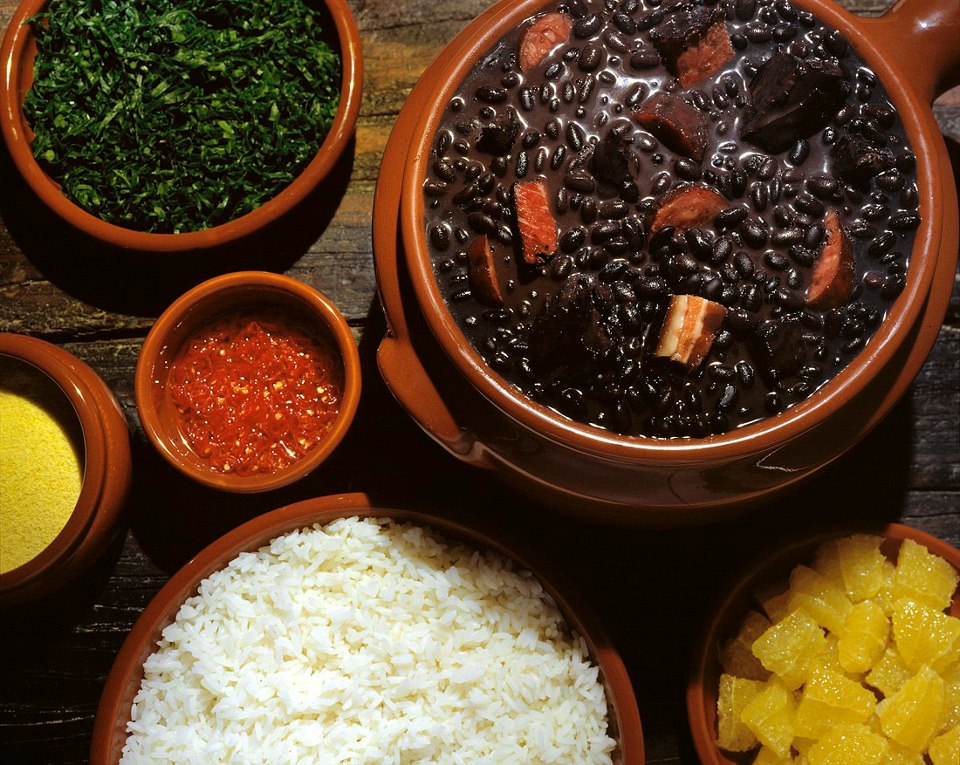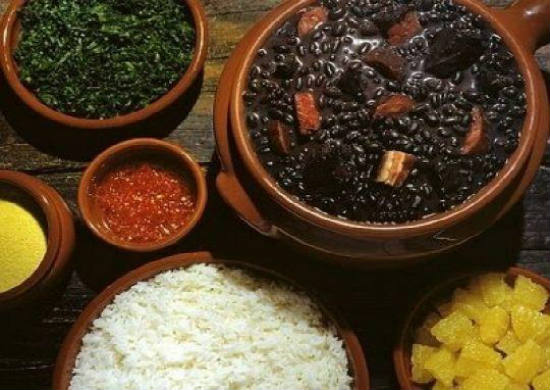

The ethnic mixture and the diversified climate of Brazil have been responsible for the creation of one of the most varied kitchens in South America. For centuries Brazilian cooks have borrowed from the foods of other people, then combined them with their own to produce an interesting and fascinating wide-ranging culinary world.
Aboriginal Indians; West African and Portuguese — both influenced by the Moors — and other ethnic foods such as German, Italian, Japanese, Syrian/Lebanese, etc. have entered into the cuisine of that vast country of some 188 million.
Before the white man arrived, the Indigenous people cultivated beans, corn, peanuts, sweet potatoes and manioc root — their principal food. Rice was introduced into the Iberian Peninsula by the Arabs and was subsequently brought to Brazil by the Portuguese while bananas, coconuts and yams came along with the African slaves. In the subsequent years, from these food crops, rice and especially beans became the basic diet of the Brazilians, so much so, that Brazil became known as ‘the land of beans’.
All these influences combined to give Brazil a rich and varied kitchen. No more is this evident than in Rio de Janeiro, a city of some 6.5 million which for two centuries was the country’s capital. World-wide the most well-known of Brazil’s urban centers, the city has much to offer.
It is one of the most visited metropolises in South America, noted for its natural setting of postcard beauty. Called by some travellers ‘a paradise of entertainment’, the city offers legendary night life, a world-renowned carnival and the samba, a stirring sexy dance favoured by tourists. Some of the most famous landmarks in the city include a series of fine crowded beaches such as Copacabana Beach, Sugarloaf Mountain and the huge statue of Christ the Redeemer, Cristo Redentor, located atop the nearby Corcovado Mountain. It is the largest Art Deco statue in the world and the second largest statue of Jesus to be found in any country.

Of course there are many, many more attractions, but they are all dominated by the country’s exciting cuisine — making for fine dining in the 1,395 restaurants in the Rio de Janeiro region. Besides international foods, there are a wide number of traditional dishes, full of intense mouth-watering flavors that are special to the Rio de Janeiro area of the country.
Here visitors can find the best churrasco, a dish which is prepared with up to ten different kinds of barbecued meat — from beef, chicken, lamb and pork to other types of meat and meat products; the soup leão veloso, a broth of seafood; Tutu à Mineira, a bean side dish; quindim, a succulent cake and the tasty baba de moca, both made with egg yolks and coconut and Caipirinha, a very refreshing drink based on cane liquor.
However, the epitome of the Rio de Janeiro cuisine, in fact, of the whole Brazilian kitchen is feijoada — a medley of countless ingredients called the diva of Rio’s dishes and the national dish of the country. This complicated mixture of beans, salted meats, sausages and rice is considered by the inhabitants to be the king of all eatables. However, its preparation is time consuming and, therefore, it is extremely hard to find in restaurants. When it is, it is probably the most ordered item on the menu. It is traditionally made with every part of the pig, including the ears, the tail and the nose, though times have changed for tourists’ tastes and in restaurants, usually only the best part of the pork is used in its preparation. In homes, it is traditionally served only at noon on Saturdays.
In the past, feijoada, in which today Brazilian food reaches its culinary height, was known as a lowly peasant food and most of the well-to-do were ashamed to offer it to guests. Today, it is a different story. Even in the best of homes it is served, especially to large festive gatherings. When prepared for these banquets, this dish, as its name feijoada completa implies, is by itself a complete gourmet meal.
Feijoada Completa – Complete Bean and Rice Meal:
Feijoada – Bean Dish
- 4 tablespoons cooking oil
- 2 medium sized onions, chopped
- 4 cloves garlic, crushed
- 1 medium hot pepper, seeded and finely chopped
- 1 1/2 pounds hot sausage, any type, whole
- 1 1/2 pounds uncooked corn beef, cut into 2 pieces
- 1 1/2 pounds lean beef, cut into 2 pieces
- 2 1/2 cups dried black beans, washed (other types of beans can be substituted)
- 6 cups water
- 2 cups grapefruit juice
- 1/2 cup finely chopped fresh coriander (cilantro) leaves)
- 1 1/2 teaspoons ground ginger
- 1 teaspoon dried oregano
- 1 teaspoon salt
- 1 teaspoon freshly ground black pepper
- 1 teaspoon cumin

Heat oil in a large saucepan, then sauté onions, garlic and hot pepper over medium heat for 5 minutes. Add sausage, then stir-fry for another 10 minutes. Add remaining ingredients and increase the water, if needed, to at least 1 inch above the beans and meat, then bring to a boil. Cook over low heat for 2 1/2 hours or until the meat and beans are well done, adding more water if necessary.
In the meantime, prepare the following side dishes:
Cooked Rice
- 4 tablespoons butter
- 1 medium sized onion, finely chopped
- 2 cloves garlic, crushed
- 1 1/2 cups white, long grained rice
- 3 cups water
- 1/2 teaspoon salt
- 1/4 teaspoon freshly ground black pepper
Melt butter in a large frying pan, then stir-fry onion and garlic over medium/low heat for 10 minutes. Add rice, then stir-fry for further 1 minute. Stir in remaining ingredients and bring to a boil. Cover then cook over medium/low heat for 15 minutes. Stir then turn off heat and re-cover and allow to cook in own steam for further 30 minutes. Place on a serving platter, but keep warm.
Cooked Collard or Kale
- 4 tablespoons cooking oil
- 1 medium sized onion, finely chopped
- 2 cloves garlic, crushed
- 1 bunch collard or kale, about 1 1/2 pounds, washed and the thick ends removed, then chopped
- 1 teaspoon salt
- 1/2 teaspoon freshly ground black pepper
- 4 tablespoons lemon juice
Heat oil in a large frying pan, then stir-fry onion and garlic over medium/low heat for 10 minutes. Add collard or kale then sprinkle with the salt and pepper. Cover then turn heat to low and cook for 25 minutes. Stir in lemon juice then place on a serving platter, but keep warm.
Sliced Oranges
3 medium sized oranges, peeled and thinly sliced, then placed artistically on a serving platter
How to Serve
Remove the meat and sausage from the beans then slice. Place each type of meat on separate platters and the beans in a serving bowl.
After placing all the dishes on the table, each person should place rice in the middle of his/her plate, then top with beans. Surround, separately, with the meat, collard or kale and orange slices.
Note: This feijoada completa meal serves of about 10.
If You Go:
Some Fine Dining Places Serving Traditional Brazilian Food in Rio de Janeiro
There are literally hundreds of culinary establishments in Rio de Janeiro. These few serving traditional Brazilian food are a sample of the city’s tourist culinary drawing cards:
Porcão Rio’s Churrascaria, its delicious grilled meat makes it the best churrascaría in Rio. Located on Aterro do Flamengo beach, it is an ideal eating place for meat lovers. The view and the service are both excellent. https://www.porcao.com.br/
Churrascaria Carretão, here one can eat a traditional Brazilian meal at a reasonable price. Service is great – an all-round place where to enjoy a Brazilian steakhouse and its delicious and tender meat. Rua Visconde de Piraja 112, Rio de Janeiro, Telephone: (21) 2267.3965 https://www.carretaochurrascaria.com.br/
Bar do Mineiro, this modest no frills establishment has the best feijoada in all of Rio and best of all the prices are very reasonable. Rua Paschoal Carlos Magno 99. Santa Teresa, Rio de Janeiro.
https://bardomineiro.net
Casa da Feijoada, a casual place serving traditional Brazilian fare – noted especially for its feijoada, which unlike other Rio eating places, is served every day instead of just on Saturday.
Rua Prudente de Moraes 10 Ipanema, Rio de Janeiro
https://www.cozinhatipica.com.br/?content=restaurante&id=4
Casa Rosa, a bright-pink house which was a former brothel, located on the Laranjeiras hillside, it is a must for everyone who is travelling to Rio. Amid this breathtaking scene every Sunday afternoon feijoada, accompanied by samba entertainment. is served on the terrace to those seeking a true Brazilian experience. : Rua Alice 550, Laranjeiras, Rio de Janeiro https://www.casarosa.com.br/
Author bio: Habeeb Salloum is a Canadian author who grew up in Saskatchewan, joined the RCAF during the Second World War, and then worked for the Canadian Department of National Revenue for 36 years. For the last 30 years he has been a full-time freelance writer and author specializing in food, history and travel. Besides 7 books and 20 chapters in books, he has had hundreds of articles about culture, food, travel, history and homesteading in western Canada appear in such publications as the Toronto Star, the Globe and Mail, the Western Producer, Contemporary Review, Forever Young, Vegetarian Journal and Saveur.
His most recent cookbook published is Asian Cooking Made Simple: A Culinary Journey Along the Silk Road and Beyond (Sweet Grass Books/Far Country Press, 2014).
- How to Get Around in Sydney: A Local’s Guide to Traveling Around Sydney - April 24, 2024
- The Low-Key Magic of Ghent, Belgium - April 22, 2024
- Discover the Hidden Charm of Extremadura in Spain - April 20, 2024

Wow! It’s a great Post for travel & food information. Here shared this food recipe is amazing & very helpful for every traveler. Thank you so much Mr. Habeeb.
Great article about Rio’s foods. I always enjoy reading Habeeb Salloum’s travel and food destination articles – he brings far-off places to life and even better, provides recipes that are easy to follow. Thanks!